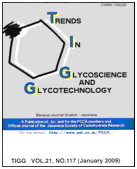All issues

Volume 22, Issue 124
Special Issue on Hyaluronan
Displaying 1-5 of 5 articles from this issue
- |<
- <
- 1
- >
- >|
PREFACE
-
Masaki YanagishitaArticle type: PREFACE
2010 Volume 22 Issue 124 Pages 55-56
Published: 2010
Released on J-STAGE: July 07, 2010
JOURNAL FREE ACCESSDownload PDF (659K)
MINIREVIEW
-
Kazu MatsumotoArticle type: MINIREVIEW
2010 Volume 22 Issue 124 Pages 57-67
Published: 2010
Released on J-STAGE: July 07, 2010
JOURNAL FREE ACCESSHyaluronan (HA) is a large, linear polymer of repeating disaccharide units composed of N-acetyl-D-glucosamine and D-glucuronic acid. Although HA has a very simple structure, it plays a key role in tissue organization and homeostasis through its physicochemical properties and its interactions with binding proteins and/or specific cell surface receptors.
Recently, using Prx1-Cre transgenic mice, we generated conditional knockout mice, in which the Has2 gene was limb bud mesoderm-specific inactivated. In this review, we describe the role of HA during limb morphogenesis, which was analyzed in Has2 conditional knockout mice crossed with Prx1-Cre. We further discuss the biochemical and genetic studies of proteoglycan aggregates, which are mainly composed of HA, aggrecan, and link protein. We also focus briefly on the role of CD44, which is a major cell surface receptor of HA. Although much is known about the function of HA, much remains to be learned about how HA is regulated and/or how HA regulates tissue homeostasis. We hope this review provides an important opportunity to consider the roles of HA and that it may prove helpful in understanding the function of HA.View full abstractDownload PDF (1483K) -
Atsushi KonArticle type: MINIREVIEW
2010 Volume 22 Issue 124 Pages 68-79
Published: 2010
Released on J-STAGE: July 07, 2010
JOURNAL FREE ACCESSThe skin is an important organ that not only covers the body but also performs various functions, such as temperature regulation, respiration, sensory functions, and immune functions. Therefore, if the functions of the skin are lost, the entire body would be affected and we would be unable to live. Recent studies have shown that hyaluronan is an important factor that maintains skin homeostasis by regulating skin development, proliferation, differentiation, regeneration, and anti-aging. On the other hand, it has been revealed that hyaluronan is also a risk factor that facilitates proliferation and metastasis of malignant skin tumors. Accordingly, it is expected that if the expression of hyaluronan in the skin can be artificially and freely regulated, it should be possible to maintain not only a person's skin health but also their general health. In this review, I outline the importance of hyaluronan, focusing on the correlation between skin hyaluronan and the pathophysiology of the skin.View full abstractDownload PDF (1153K) -
Lisheng Zhuo, Koji KimataArticle type: MINIREVIEW
2010 Volume 22 Issue 124 Pages 80-88
Published: 2010
Released on J-STAGE: July 07, 2010
JOURNAL FREE ACCESSHyaluronan (HA) has been reported to be associated with the progression of various inflammatory diseases and cancer malignancy. The serum level of HA is a clinical biomarker for rheumatoid arthritis and liver cirrhosis, conditions in which elevated HA levels are due to the enhanced production in the joint synovium and impaired uptake and clearance in the hepatic sinusoidal endothelium, respectively. We have discovered that inflammation is often accompanied by the covalent modification of HA by serumderived HA-associated protein (SHAP), derived from theheavy chains of the plasma protein inter-alpha-trypsin inhibitor, which changes the biological activity of HA and participates in regulation of the inflammatory response. We compared the serum levels of SHAP and HA in a number of diseases. The results indicated that the SHAP level was more closely correlated with disease stages and with the other related biomarkers than was HA. This review summarizes these findings and concludes that SHAP is superior to HA as a disease marker.View full abstractDownload PDF (670K)
GLYCOTOPIC
-
Yuko NaitoArticle type: GLYCOTOPIC
2010 Volume 22 Issue 124 Pages 89-91
Published: 2010
Released on J-STAGE: July 07, 2010
JOURNAL FREE ACCESSDownload PDF (669K)
- |<
- <
- 1
- >
- >|